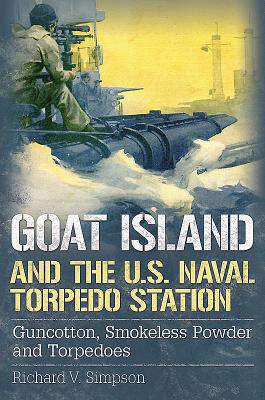
- Afhalen na 1 uur in een winkel met voorraad
- Gratis thuislevering in België vanaf € 30
- Ruim aanbod met 7 miljoen producten
- Afhalen na 1 uur in een winkel met voorraad
- Gratis thuislevering in België vanaf € 30
- Ruim aanbod met 7 miljoen producten
Zoeken
Goat Island and the U.S. Naval Torpedo Station: Guncotton, Smokeless Powder and Torpedoes
Richard Simpson
Hardcover | Engels
€ 40,45
+ 80 punten
Omschrijving
Weak maritime nations have always sought to augment the strength of their coastal defenses and navies by the use of "diabolical" contrivances for destroying an invader's ships.
The history of the adoption of the torpedo as a recognized implement of warfare is not unlike that of gunpowder or of exploding shells. Each in its turn was met by the cry, "Inhuman, barbarous, unchivalrous."
During the American Civil War, the Confederate Navy employed submerged mines, called torpedoes, and explosive charges mounted on a long pole referred to as the "spar torpedo" which was bumped into the hull of an enemy vessel exploding on contact.
These weapons enjoyed great success during the conflict. In July 1869, the Secretary of the Navy announced the establishment of the Naval Torpedo Station on Goat Island in the harbor of Newport, Rhode Island, for development of a more sophisticated and deadlier self-propelled torpedo.
From its founding until the end of the Second World War, the Naval Torpedo Station has been the Navy's principal center for the design of torpedoes.
Newport continues as the home of the U.S. Navy's most important laboratory for research and development of modern weapons' systems.
The history of the adoption of the torpedo as a recognized implement of warfare is not unlike that of gunpowder or of exploding shells. Each in its turn was met by the cry, "Inhuman, barbarous, unchivalrous."
During the American Civil War, the Confederate Navy employed submerged mines, called torpedoes, and explosive charges mounted on a long pole referred to as the "spar torpedo" which was bumped into the hull of an enemy vessel exploding on contact.
These weapons enjoyed great success during the conflict. In July 1869, the Secretary of the Navy announced the establishment of the Naval Torpedo Station on Goat Island in the harbor of Newport, Rhode Island, for development of a more sophisticated and deadlier self-propelled torpedo.
From its founding until the end of the Second World War, the Naval Torpedo Station has been the Navy's principal center for the design of torpedoes.
Newport continues as the home of the U.S. Navy's most important laboratory for research and development of modern weapons' systems.
Specificaties
Betrokkenen
- Auteur(s):
- Uitgeverij:
Inhoud
- Aantal bladzijden:
- 192
- Taal:
- Engels
Eigenschappen
- Productcode (EAN):
- 9781634990134
- Verschijningsdatum:
- 21/11/2016
- Uitvoering:
- Hardcover
- Formaat:
- Genaaid
- Afmetingen:
- 163 mm x 239 mm
- Gewicht:
- 544 g

Alleen bij Standaard Boekhandel
+ 80 punten op je klantenkaart van Standaard Boekhandel
Beoordelingen
We publiceren alleen reviews die voldoen aan de voorwaarden voor reviews. Bekijk onze voorwaarden voor reviews.











